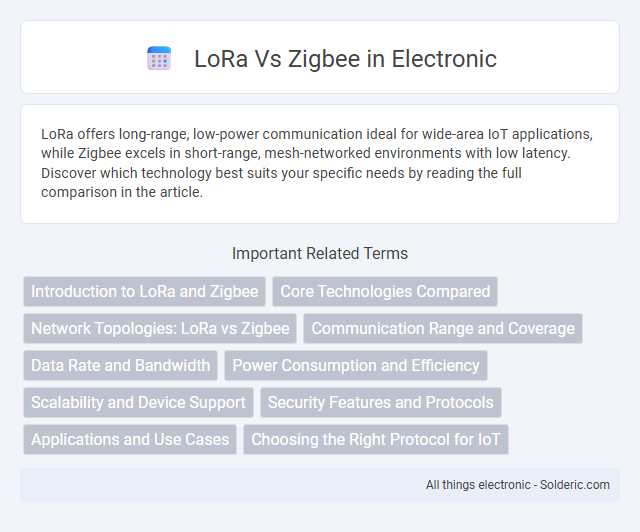LoRa offers long-range, low-power communication ideal for wide-area IoT applications, while Zigbee excels in short-range, mesh-networked environments with low latency. Discover which technology best suits your specific needs by reading the full comparison in the article.
Comparison Table
| Feature | LoRa | Zigbee |
|---|---|---|
| Frequency | Sub-GHz (e.g., 868 MHz, 915 MHz) | 2.4 GHz |
| Range | Up to 15 km (rural) | 10-100 meters |
| Data Rate | 0.3 - 50 kbps | 250 kbps |
| Power Consumption | Very low (suitable for battery-powered devices) | Low (optimized for short range) |
| Network Topology | Star | Mesh |
| Use Cases | Long-range IoT, smart agriculture, asset tracking | Home automation, industrial control, sensor networks |
| Standard | LoRaWAN | IEEE 802.15.4 / Zigbee Alliance |
| Security | 128-bit AES encryption | 128-bit AES encryption |
Introduction to LoRa and Zigbee
LoRa and Zigbee are wireless communication technologies designed for different Internet of Things (IoT) applications. LoRa provides long-range, low-power connectivity ideal for wide-area networks, supporting distances up to 10 kilometers with minimal energy consumption. Zigbee, on the other hand, excels in short-range, low-power mesh networking often used in home automation and smart devices, offering reliable communication within a range of about 100 meters.
Core Technologies Compared
LoRa operates on long-range, low-power wide area network (LPWAN) technology using chirp spread spectrum modulation, enabling communication over distances up to 15 kilometers with minimal power consumption. Zigbee employs IEEE 802.15.4 standard for short-range mesh networking, optimized for low data rates and secure, reliable device-to-device communication within a range of up to 100 meters. LoRa excels in wide-area IoT applications requiring low bandwidth and extended battery life, while Zigbee suits local, high-density sensor networks demanding low latency and robust mesh connectivity.
Network Topologies: LoRa vs Zigbee
LoRa supports star and star-of-stars topologies, enabling long-range, low-power communication suitable for wide-area networks with centralized gateways. Zigbee utilizes mesh topology, allowing devices to relay data through multiple nodes, enhancing network robustness and self-healing capabilities in short-range applications. The choice between LoRa and Zigbee topologies depends on the specific requirements for range, power consumption, and network scalability.
Communication Range and Coverage
LoRa technology offers a significantly longer communication range, often exceeding 10 kilometers in rural areas, making it ideal for wide-area IoT deployments. Zigbee, on the other hand, typically supports ranges up to 100 meters per hop but extends its coverage through mesh networking by connecting multiple devices. Your choice depends on whether you prioritize long-distance coverage with LoRa or robust local network scalability via Zigbee's mesh capabilities.
Data Rate and Bandwidth
LoRa offers lower data rates ranging from 0.3 kbps to 50 kbps, optimized for long-range, low-power IoT applications with bandwidth typically between 125 kHz and 500 kHz. Zigbee provides higher data rates around 250 kbps, designed for short-range communication with a fixed bandwidth of 2 MHz in the 2.4 GHz ISM band. The choice depends on whether extended range or faster data transmission within a localized network is the priority.
Power Consumption and Efficiency
LoRa technology offers ultra-low power consumption ideal for long-range communication with devices operating for years on a single battery, making it highly efficient for wide-area IoT deployments. Zigbee consumes more power due to its mesh networking capabilities, which require frequent signal retransmissions, but provides faster data rates suitable for short-range, high-density sensor networks. The efficiency of LoRa is best leveraged in sparse, battery-sensitive applications, while Zigbee excels in environments demanding low-latency communication and device interoperability within localized networks.
Scalability and Device Support
LoRa offers exceptional scalability with support for thousands of devices across vast distances, ideal for large-scale IoT deployments in smart cities and agriculture. Zigbee provides robust device support within smaller, localized networks, excelling in home automation and industrial control systems with low power consumption. LoRa's long-range connectivity surpasses Zigbee's mesh network, making it better suited for wide-area networks requiring extensive device integration.
Security Features and Protocols
LoRa employs AES-128 encryption at the network, application, and device levels, ensuring robust end-to-end security suitable for long-range, low-power IoT applications. Zigbee also utilizes AES-128 encryption but incorporates additional security protocols like frame counters and key management for protecting network integrity and preventing replay attacks. Choosing between these technologies for your IoT network depends on the balance between range requirements and the specific security mechanisms needed for your data protection.
Applications and Use Cases
LoRa technology excels in long-range, low-power communication, making it ideal for applications such as smart cities, agricultural monitoring, and remote environmental sensing. Zigbee is preferred for short-range, low-power mesh networks commonly used in home automation, industrial control systems, and lighting solutions. Both technologies address different connectivity needs: LoRa supports wide-area IoT deployments, while Zigbee is optimized for localized, device-to-device communication.
Choosing the Right Protocol for IoT
LoRa offers long-range communication up to 15 kilometers with low power consumption, ideal for wide-area IoT applications like smart agriculture and city infrastructure. Zigbee provides reliable, low-latency mesh networking suitable for indoor environments and home automation with shorter ranges around 10-100 meters. Selecting the right protocol depends on factors such as range requirements, power efficiency, network topology, and specific IoT use cases.
LoRa vs Zigbee Infographic

 solderic.com
solderic.com